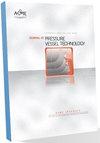原型弯管的渐进裂纹尺寸及其与A16主曲线的比较
IF 1
4区 工程技术
Q4 ENGINEERING, MECHANICAL
Journal of Pressure Vessel Technology-Transactions of the Asme
Pub Date : 2022-02-12
DOI:10.1115/1.4053850
引用次数: 1
摘要
在快中子增殖反应堆(FBR)管道系统的设计中,通常使用RCC MRx A16中给出的泄漏-破裂前(LBB)主曲线来估计渐近裂纹尺寸(2Cs)。目前的方法在FBR管道系统的LBB演示中被认为不够有效。近十年来,数值裂纹扩展研究受到了广泛的关注。基于断裂力学的基于原型尺寸管道几何形状的数值裂纹扩展研究的部署,对估计渐近裂纹尺寸产生了相当大的兴趣。本文概述了基于数值有限元的裂纹扩展研究的优点,以估计原型尺寸管件的裂纹扩展曲线。根据A16,与传统的LBB主曲线相比,数值计算过程得出了更准确、更现实的Cs估计。考虑到较低Cs值在LBB演示中的经济优势,建议采用数值方法估算FBR管道系统的Cs。本文章由计算机程序翻译,如有差异,请以英文原文为准。
Asymptotic Crack Size of a Prototype Sized Pipe Bend and Comparison with A16 Master Curve
In the design of a Fast Breeder Reactor (FBR) piping system, asymptotic crack size (2Cs) is traditionally estimated using the Leak-Before-Break (LBB) Master curve given in RCC MRx A16. The current approach is seen not to be sufficiently efficient in the LBB demonstration of FBR piping systems. Numerical crack growth studies have received much attention in the past decade. Deployment of fracture mechanics based numerical crack growth studies on prototype sized pipe geometries generate considerable interest in estimating asymptotic crack size.
This paper outlines the advantages of numerical finite element based crack growth studies to estimate the Cs on a prototype sized pipe bend. The numerical procedure has resulted in an accurate and more realistic estimate of Cs than the traditional LBB Master curve as per A16. Considering the economic advantages of a relatively lower value of Cs for LBB demonstration, it is recommended to adopt the numerical method to estimate Cs for the FBR piping system.
求助全文
通过发布文献求助,成功后即可免费获取论文全文。
去求助
来源期刊
CiteScore
2.10
自引率
10.00%
发文量
77
审稿时长
4.2 months
期刊介绍:
The Journal of Pressure Vessel Technology is the premier publication for the highest-quality research and interpretive reports on the design, analysis, materials, fabrication, construction, inspection, operation, and failure prevention of pressure vessels, piping, pipelines, power and heating boilers, heat exchangers, reaction vessels, pumps, valves, and other pressure and temperature-bearing components, as well as the nondestructive evaluation of critical components in mechanical engineering applications. Not only does the Journal cover all topics dealing with the design and analysis of pressure vessels, piping, and components, but it also contains discussions of their related codes and standards.
Applicable pressure technology areas of interest include: Dynamic and seismic analysis; Equipment qualification; Fabrication; Welding processes and integrity; Operation of vessels and piping; Fatigue and fracture prediction; Finite and boundary element methods; Fluid-structure interaction; High pressure engineering; Elevated temperature analysis and design; Inelastic analysis; Life extension; Lifeline earthquake engineering; PVP materials and their property databases; NDE; safety and reliability; Verification and qualification of software.

 求助内容:
求助内容: 应助结果提醒方式:
应助结果提醒方式:


